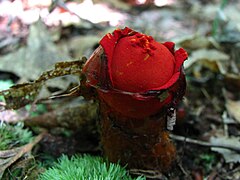Calostoma cinnabarinum
| Calostoma cinnabarinum | |
|---|---|
 |
|
| Scientific classification | |
| Kingdom: | Fungi |
| Phylum: | Basidiomycota |
| Class: | Agaricomycetes |
| Order: | Boletales |
| Family: | Sclerodermataceae |
| Genus: | Calostoma |
| Species: | C. cinnabarinum |
| Binomial name | |
|
Calostoma cinnabarinum Desv. (1809) |
|
| Synonyms | |
|
|
Calostoma cinnabarinum is a species of gasteroid fungus in the family Sclerodermataceae, and is the type species of the genus Calostoma. It is known by several common names, including stalked puffball-in-aspic and gelatinous stalked-puffball. The fruit body has a distinctive color and overall appearance, featuring a layer of yellowish jelly surrounding a bright red, spherical head approximately 2 centimeters (0.8 in) in diameter atop a red or yellowish brown spongy stipe 1.5 to 4 cm (0.6 to 2 in) tall. The innermost layer of the head is the gleba, containing clear or slightly yellowish elliptical spores, measuring 14–20 micrometers (µm) long by 6–9 µm across. The spore surface features a pattern of small pits, producing a net-like appearance. A widely distributed species, it grows naturally in eastern North America, Central America, northeastern South America, and East Asia. C. cinnabarinum grows on the ground in deciduous forests, where it forms mycorrhizal associations with oaks.
Despite its appearance and common name, C. cinnabarinum is not related to the true puffballs or to species in the genus Podaxis (also commonly called "stalked puffballs"). It is also unrelated to earthstars and stinkhorns. However, C. cinnabarinum has had a complex taxonomic history that at various times confused it with each of those groups, until the advent of molecular phylogenetics. Although eaten or used in folk medicine in some areas, it is typically considered inedible.
...
Wikipedia
